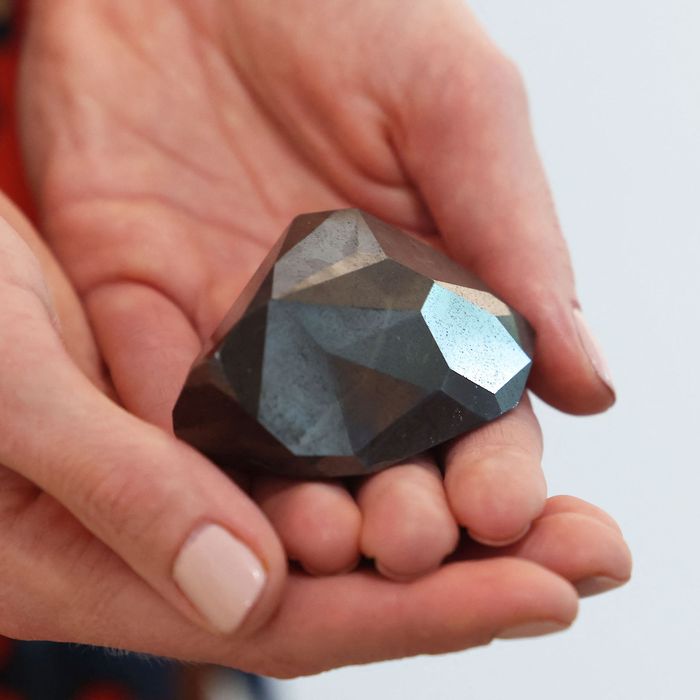A Massive Black Diamond, Allegedly From Outer Space, Is Now on the Market.
The 'Enigma' diamond is projected to sell for approximately $7 million at auction, despite experts' doubts about its cosmic origin.
:focal(512x449:513x450)/https://tf-cmsv2-smithsonianmag-media.s3.amazonaws.com/filer_public/0b/6b/0b6beda8-a8a5-46ba-bc26-71026b085298/enigma1.jpeg)
Key Highlights
- The "Enigma," a one-of-a-kind black diamond, will be auctioned next month and is projected to fetch more than $7 million USD.
- The diamond was exhibited Tuesday by Sotheby's Dubai, which claims the colossal black stone originated in space.
- The Enigma, which was cut to an exact weight of 555.55 carats and features 55 facets, is thought to be the world's biggest cut black diamond.
- The Enigma weighs 555.55 carats, about the same as a deck of playing cards.
- Some diamond specialists have disputed the gem's origins in outer space, stating that the Enigma might have been created on Earth.
Advertisement

The "Enigma," a one-of-a-kind black diamond, will be auctioned next month and is projected to fetch more than $7 million USD. The diamond was exhibited Tuesday by Sotheby's Dubai, which claims the colossal black stone originated in space.
The Enigma, which was cut to an exact weight of 555.55 carats and features 55 facets, is thought to be the world's biggest cut black diamond.
"The form of the diamond is inspired by the Middle Eastern palm emblem known as the Khamsa, which represents power and protection," jewellery specialist Sophie Stevens tells the Associated Press. Because the Arabic word "Khamsa" means five, "there is a wonderful motif of the number five going throughout the diamond," she explains.
Earlier this week, the jewel was on display before travelling to Los Angeles and then to London for the February online auction. According to Sotheby's, the diamond is expected to bring at least 5 million British pounds ($approximately $6.8 million USD) due to its exceptional hue, shape, and weight. The diamond will be available for bidding online from February 3 to 9, and according to CNN's Isabelle Jani-Friend, Sotheby's will also accept bitcoin payments.
The diamond's alleged cosmic origin is another important selling feature. According to a press release from the auction house, the Enigma is "thought to have been created either by a meteoric impact or having actually emerged from a diamond-bearing asteroid that collided with Earth."
However, other specialists continue to be suspicious of these extraterrestrial claims. "I'm not certain it originated from outer space," Tim McCoy, director of the Smithsonian National Museum of Natural History's meteorite collection, tells NPR's Debbie Elliot.
Advertisement
/https://tf-cmsv2-smithsonianmag-media.s3.amazonaws.com/filer_public/4c/f4/4cf40889-c0ea-4e6e-ab52-6abd10aaeb11/enigma_3.jpeg)
The Enigma weighs 555.55 carats, about the same as a deck of playing cards
Some diamond specialists have disputed the gem's origins in outer space, stating that the Enigma might have been created on Earth. Black diamonds get their eerie tint as a result of large concentrations of minerals such as graphite that veil the stone. The Enigma is most likely a carbonado diamond, a form of black diamond that looks far darker than ordinary black diamonds because of its light-absorbing structure.
Carbonado diamonds have previously been discovered in either Brazil or the Central African Republic, yet the actual process by which these diamonds develop remains a mystery. While some black diamonds do have cosmic origins, meteorite-created jewels are typically far smaller than the Enigma. According to McCoy, it may have developed beneath the Earth some 4 billion years ago, but no one knows for certain.
According to Live Science's Harry Baker, the fact that the Enigma has been chopped additionally complicates deducing information regarding its origin. The exterior surfaces of carbonados very certainly include traces of their origin, which are now likely destroyed, "he continued, casting doubt on the auction house's assertion that the diamond originated in space.
We think of outer space as this very fascinating area, but we should think of the interior of Earth as equally fascinating. We have a limited understanding of what the deep, deep Earth is like, "McCoy informs NPR. Every rock has a tale to tell. We simply need to learn how to listen. And I believe this is a rock whose narrative we do not yet fully grasp. However, when someone finds it out, it's going to be a pretty fantastic one. "
Advertisement